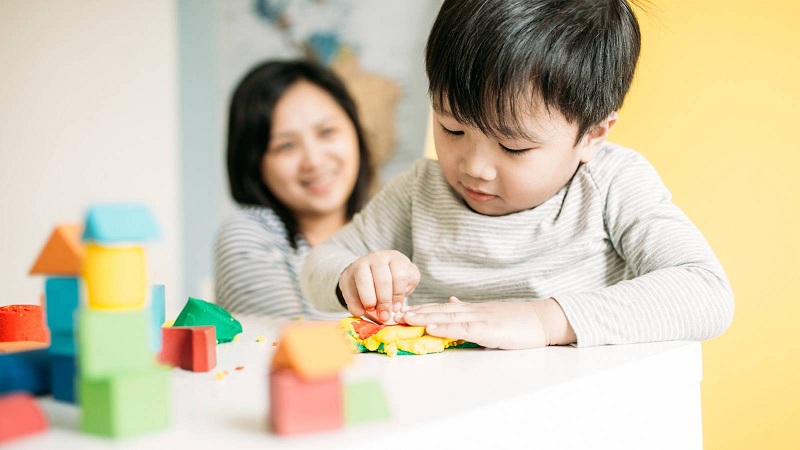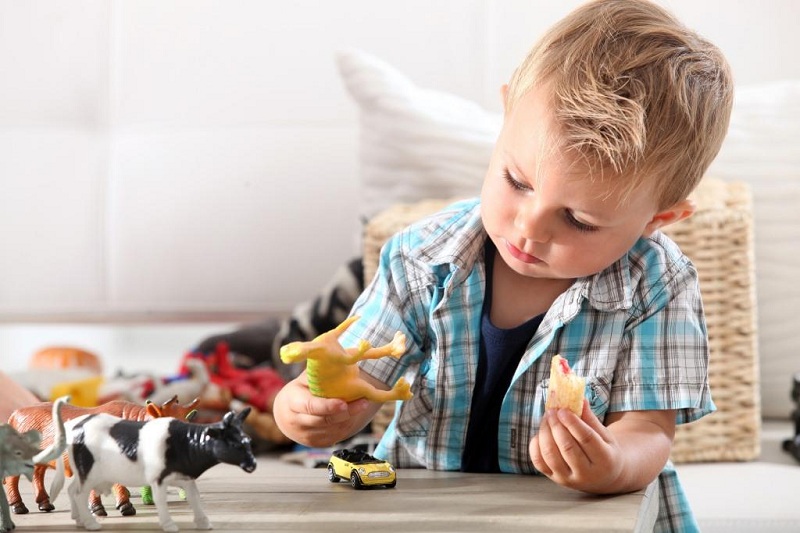All parents know that a child needs to be given enough time and attention. But when a baby literally goes everywhere with a “tail” for a mom or dad, constantly demanding this attention and not even trying to do something for themselves on a little, it becomes difficult to cope with this state of affairs. In this article, we will try to find out why the child should play on his own, and how to teach him to engage himself.

Why should a child be able to play himself?
To begin with, in principle, the kid should be able to play on his own (except for the reason that you simply cannot spend 100% of your time every day). Immediately, we note: we are not talking about the fact that the child is constantly playing exclusively by himself. He definitely needs time spent with his parents and other adults, as well as joint activities with peers. That is, the baby should, in principle, be able to occupy himself, and do it periodically, and not always. And you need this for the following reasons:
- Independence. This is obvious: if a child does not get used to making even such simple decisions as a game or another way to entertain himself, then it will be extremely difficult for him to become independent in the future. In fact, the methods of independent pastime are the first own decisions of the child, which he makes consciously. The requirement to give him a spoon, the refusal to eat some kind of food or to wear some kind of wardrobe does not compare with these decisions in terms of significance for the development of a child’s personality.

- Creativity. In education, in principle, it is important to maintain a delicate balance between the two extremes: imposing patterns of behavior and their complete absence. The child needs some rules, algorithms that he can follow to harmoniously integrate into society. At the same time, he also needs the absence of fear of actions for which there are no rules, which can be carried out at one’s own discretion. And the ability to engage yourself independently perfectly helps in getting rid of this fear.
- “Separation” from parents. The whole process of growing up a child, in fact, is aimed at separation from mom and dad, that is, to receive all that will allow the current baby to become a full-fledged and self-sufficient adult in the future. All stages of separation have their own terms. Naturally, a two-year-old child should not be left alone at home, and the need for personal space is much lower for him than for teenagers. But at least sometimes playing independently, without absolute dependence on the parents, such a child can already (though, most likely, he will be calmer if his mom or dad stays in his field of vision).

- Responsibility for spending your time. This reason is relevant for older children, in whose activity the games still occupy a decent part, for example, for children of preschool or primary school age. They will have to get used to a more and more intensive training regime, and, ideally, begin to learn effective time management. Understanding the direct relationship between how they managed their time, and how much of it they have left, is very useful for them, as well as an understanding of the ability to influence these parameters.
So, playing on your own is not so important, in toys, with a ball, with a branch, in some fantasy things of your own – the child is still worth it. And if your baby is not able to do it yet, it’s time to teach him.
How to teach a child to play on their own?
It is important to understand that a child who does not have the habit of playing on his own cannot form it instantly. That is, the process of schooling will be gradual, but the sooner you start it – the sooner it will bear fruit. So, we recommend following these tips.
Offer your child real options
More often than not, parents who are too bothered by an undersized child say something in the spirit of “well, go play something already,” or “your toys lie there, play with them.” And this, of course, does not work. But if you offer your child to play some specific game with some specific objects, then the probability that he will listen to you will increase many times over. Most likely, after a while he will come to you again – then you can ask him about how he played, and offer him what (something concrete) he could do next.

Read the instructions carefully.
Now it is especially important because manufacturers produce a huge number of mind-blowing toys with a variety of mechanisms. And not always an adult person will immediately understand how to play it – let alone a child. Therefore, when you buy a baby a new toy (especially developing one), clearly and, most likely, repeatedly explain to him what to do with it. The show, play with him, make sure that he understood everything and can really play with her on his own.
Train parting
First, you need to find some excuses, real or game. For example, you can tell your child that you need to throw things into the washing machine and that as soon as you do this, you will immediately return (otherwise he will follow you or be nervous). Or, for example, if you play a doctor – you can go “on a call to another patient.” Play store – go “take the goods.” Thanks to such training over time you will be able to leave the baby alone and without any explanation.

Do not interrupt and encourage research interest.
Curiosity, the desire to explore the world, to try everything, to see and touch – this is something that is absolutely natural for any child. But sometimes parents, without even realizing it, suppress this natural aspiration. For example, they are angry because of the numerous “why” that is poured on them as if from a horn of plenty, or hurrying somewhere, do not allow a child to consider another bug, a leaf or a squiggle on a wrought fence. If this happens often, then a natural conclusion is formed in the child’s mind: it is not good for parents to be interested in all sorts of things, parents don’t like it to do so. And he tries to tame his natural curiosity.

It is clear that you cannot answer all the “why”, and sometimes it is really more important, for example, to have time for an appointment with a doctor than to thoroughly study some branch. But try not to mix negatives in such situations. Explain to the child that, in general, all this is really very interesting, but for such and such a reason it is now specifically necessary to digress from these interesting studies. If your child is curious and does not think it is bad, then it will be much easier for him to play on his own too.
Help your child find a hobby
This advice is unlikely to be suitable for very young children aged 2-4 years, but older guys may well get involved in a lot of things than drawing, music, dancing, designers, etc. But it is obvious that it’s quite difficult for a 5-7-year-old child to simply start and start doing something as a hobby. Therefore, make it so that he tried various types of hobbies, and if he likes some of them, create the conditions for practicing them. At the same time, it is important to give the child a try and that, and another, and the third. And drawing, and football, and needlework, and dancing are all that he is interested in at least a little. Otherwise, the likelihood is very high that you will impose on him the hobby you would like him to do. And not what he would like to do himself.
Create a kids space
If the child does not have his own room, it may just be a corner in the common room. The main thing is that the baby has a zone in which he can create whatever he wants. You can place toys in this area, hang up educational complexes on the walls, ideally even donate wallpaper. In other words, in this space, the child should have absolutely no restrictions. Therefore, it should not be sharp, piercing and cutting objects, preferably windows, and similar theoretical objects.

Quite often, the child does not want to play alone, because he is afraid of breaking some rules. Surely he had already broken something, and they blamed him for it, and he was afraid of a repetition of the situation. Suddenly, in a fit of a game, he will ruin something again (and he will not understand it himself), and will he be disturbed? After all, believe me, cutting the papa’s shirt to tie up the injured teddy bear of his wounds, the kid has no purpose to harm you. He is simply in his fantasies, in which his actions are absolutely logical. And you see only the spoiled thing, not knowing the whole background.
Therefore, the creation of a special space of “permissiveness” will save your nerves, and will save the child from unnecessary fears and fears. And it will be much more pleasant for him to play independently in such a space.
Change the setting
As has been repeatedly noted, the child likes to learn everything. But what to study where everything is already known and understood? Therefore, it is impossible that the whole situation in the child’s room or in the children’s area remains unchanged. Periodically (once in 2-3 weeks), swap everything that is possible. And if the child accidentally forgot about some interesting game or thing – throw it in a prominent place, as a seed for his interest. If he does not know how to play himself, then such unobtrusive help will have the desired effect if only because of the stimulation of children’s curiosity.
Teach reading and not cartoons
Cartoons are a simple way to take a child for a long time, but not very good. Even if we are talking about some kind of “developing,” supposedly useful cartoons, in which some material is presented. All the same, they remain moving pictures on the screen, staring at which the child can spend more than one hour. This does not stimulate his curiosity and creativity, but, on the contrary, suppresses them.

Reading is a different matter. It not only represents a more intellectual activity in principle but also develops a great imagination. A child with a developed imagination to play alone is much more interesting than a child with a poor imagination.
Thus, to teach a child to play independently is quite realistic. Consider the above tips, and gradually you and your baby will definitely succeed.




